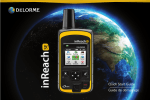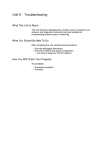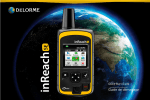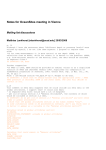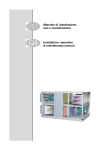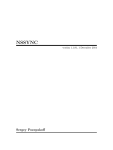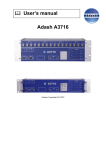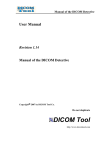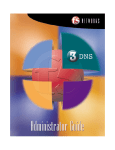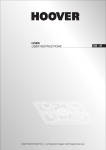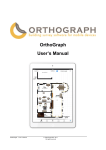Download Ethereal User's Guide
Transcript
Ethereal User’s Guide Richard Sharpe NS Computer Software and Services P/L Ethereal User’s Guide: by Richard Sharpe First edition Edition Published 2000 Copyright © 2000 by NS Computer Software and Services P/L Permission is granted to copy, distribute and/or modify this document under the terms of the GNU Free Documentation License, Version 1.1 or any later version published by the Free Software Foundation; with the Invariant Sections being LIST THEIR TITLES, with the Front-Cover Texts being LIST, and with the Back-Cover Texts being LIST. A copy of the license is included in the section entitled "GNU Free Documentation License" Table of Contents 1. Introduction................................................................................................................6 1.1. What is Ethereal? ..............................................................................................6 1.2. The status of Ethereal........................................................................................8 1.3. Development and maintenance of Ethereal ......................................................8 1.4. A rose by any other name .................................................................................8 1.5. A brief history of Ethereal ................................................................................8 1.6. Platforms Ethereal runs on................................................................................9 1.7. Where to get Ethereal......................................................................................10 1.8. Reporting problems and getting help..............................................................10 1.9. Where to get the latest copy of this document................................................10 2. Building and Installing Ethereal.............................................................................11 2.1. Introduction.....................................................................................................11 2.2. Obtaining the source and binary distributions ................................................11 2.3. Before you build Ethereal ...............................................................................12 2.4. Building from Source under UNIX.................................................................15 2.5. Installing the binaries under UNIX.................................................................15 2.6. Installing from RPMs under Linux .................................................................16 2.7. Building and Installing under Windows .........................................................16 2.7.1. Building from source under Windows .................................................17 2.8. Installing Ethereal under Windows.................................................................17 2.9. Troubleshooting during the install ..................................................................17 3. Using Ethereal ..........................................................................................................18 3.1. Introduction.....................................................................................................18 3.2. Starting Ethereal..............................................................................................18 3.3. Capturing packetsEthereal ..............................................................................19 3.4. Filtering while capturing.................................................................................19 3.5. Viewing packets ..............................................................................................19 3.6. Viewing packets while you capture ................................................................19 3.7. Saving captures ...............................................................................................19 3.8. Reading captured from other tools..................................................................19 3.9. Filtering packets while viewing ......................................................................20 3 3.10. More advanced aspects .................................................................................20 4. Troubleshooting with Ethereal ...............................................................................21 4.1. An approach to troubleshooting with Ethereal ...............................................21 4.2. Examples of troubleshooting ..........................................................................21 5. Miscellaneous Topics................................................................................................22 5.1. Capturing with tcpdump for viewing with Ethereal .......................................22 5.2. Using editpcap ................................................................................................22 5.3. Other tools.......................................................................................................22 A. The GNU Free Document Public Licence.............................................................23 A.1. Copyright .......................................................................................................23 A.2. Preamble.........................................................................................................23 A.3. Applicability and Definitions .........................................................................23 A.4. Verbatim Copying ..........................................................................................25 A.5. Copying in Quantity.......................................................................................25 A.6. Modifications .................................................................................................26 A.7. Combining Documents ..................................................................................29 A.8. Collections of Documents..............................................................................29 A.9. Aggregation with Independent Works ...........................................................30 A.10. Translation....................................................................................................30 A.11. Termination ..................................................................................................31 A.12. Future Revisions of this License ..................................................................31 4 List of Figures 1-1. Ethereal captures packets and allows you to examine their content.........................7 List of Examples 2-1. Building GTK+ from source ..................................................................................13 2-2. Building and installing libpcap...............................................................................13 2-3. Errors while installing the libpcap include files .....................................................14 2-4. ................................................................................................................................14 2-5. Installing required RPMs under RedHat Linux 6.2................................................14 3-1. Help information available from Ethereal ..............................................................18 5 Chapter 1. Introduction 1.1. What is Ethereal? Every network manager at some time or other needs a tool that can capture packets off the network and analyze them. In the past, such tools were either very expensive, propietary, or both. However, with the advent of Ethereal, all that has changed Ethereal is perhaps one the best open source packet sniffers available today. It provides the following broad functions: • Capture and display packets from any interface on a UNIX system • Display packets captured under a number of other capture programs: • tcpdump • Network Associates Sniffer and Sniffer Pro • NetXray • LANalyzer • Shomiti • AIX’s iptrace • RADCOM’s WAN/LAN Analyzer • Lucent/Ascend access products • HP-UX’s nettl • Toshiba’s ISDN routers • ISDN4BSD i4btrace utility • Microsoft Network Monitor • Sun snoop 6 Chapter 1. Introduction • Filter packets on many criteria Figure 1-1 shows Ethereal having captured some packets and waiting for you to examine the packets. Figure 1-1. Ethereal captures packets and allows you to examine their content. In addition, because all the source code for Ethereal is freely available, it is very easy 7 Chapter 1. Introduction for people to add new protocols to Ethereal, either as modules, or built into the source. There are currently protocol decoders (or dissectors, as they are known in Ethereal), for a great many protocols, including: 1.2. The status of Ethereal Ethereal is an open source software project, and is released under the GPL. All source cose is freely available under the GPL. You are welcome to modify Ethereal to suit your own needs, and it would be appreciated if you contribute your improvements back to the Ethereal team. The Ethereal source code and binary kits for some platforms are all available on the Ethereal website: http://www.zing.org. 1.3. Development and maintenance of Ethereal Ethereal was initially developed by Gerald Combs. Ongoing development and maintenance of Ethereal is handled by the Ethereal team, a loose group of individuals who fix bugs and provide new functionality. There have also been a large number of people who have contributed protocol dissectors to Ethereal, and it is expected that this will continue. 1.4. A rose by any other name William Shakespear wrote: "A rose by any other name would smell as sweet." And so it is with Ethereal, as there appears to be two different ways that people pronounce the name. Some people pronounce it ether-real, while others pronounce it e-the-real, as in ghostly, insubstantial, etc. 8 Chapter 1. Introduction You are welcome to call it what you like, as long as you find it useful. 1.5. A brief history of Ethereal Ethereal was initiall released in June 1998 as version 0.2.0. Not long after that Gilbert Ramirez saw its potential and contributed a low-level dissecotr to it. In late 1998, Richard Sharpe, who was giving TCP/IP courses, saw its potential on such courses, started looking at it to see if it supported the protocols he needed. While it didn’t at that point, new protocols could be easily added. In early 1999, Guy Harris ... 1.6. Platforms Ethereal runs on Ethereal currently runs on most UNIX platforms and the various Windows platforms. It requires GTK+, GLIB and libpcap in order to run. Binary packages are available for the following platforms: • AIX • Tru64 UNIX (formerly Digital UNIX) • Debian GNU/Linux • Slackware Linux • Red Hat Linux • FreeBSD • OpenBSD • HP/UX • Sparc/Solaris 8 9 Chapter 1. Introduction • Windows NT and 98 If a binary package is not available for your platform, you should download the source and try to build it. 1.7. Where to get Ethereal You can get the latest copy of the Ethereal from the Ethereal Website: http://www.zing.org. The website allows you to choose from among several mirrors for downloading. 1.8. Reporting problems and getting help If you have problems, or need help with Ethereal, there are several mailing lists that may be of interest to you: 1.9. Where to get the latest copy of this document The latest copy of this documentation can always be found on the Ethereal web site: http://www.zing.org. It can also be found at: TBD. 10 Chapter 2. Building and Installing Ethereal 2.1. Introduction As with all things, there must be a beginning, and so it is with Ethereal. To use Ethereal, you must: • Obtain a binary package for your operating system, or • Obtain the source and build Ethereal for your operating system Currently, only two or three Linux Distributions ship ethereal, and they are commonly shipping an out-of-date version. No other versions of UNIX ship Ethereal so far, and Microsoft does not ship it with any version of Windows. For that reason, you will need to know where to get the latest version of Ethereal and how to install it. The current version of Ethereal is 0.8.10. This chapter shows you how to obtain source and binary packages, and how to build Ethereal from source, should you choose to do so. The following are the general steps you would use: 1. Download the relevant package for your needs, eg, source or binary distribution. 2. Build the source into a binary, if you have downloaded the source This may involve building and/or installing any other necessary packages 3. Install the binaries in their final destinations 11 Chapter 2. Building and Installing Ethereal 2.2. Obtaining the source and binary distributions You can obtain both source and binary distributions from the Ethereal web site: http://www.zing.org. Simply select the download link, and then select either the source package or binary package of your choice from the mirror site closest to you. Download all the needed files: In general, unless you have already downloaded Ethereal before, you will most likely need to down load several source packages if you are building Ethereal from source. This is covered in more detail below. Once you have downloaded the relevant files, you can go on to the next step. Note: While you will find a number of binary packages available on the Ethereal web site, you might not find one for your platform, and they often tend to be several versions behind the current released version, as they are contributed by people who have the platforms they are built for. For this reason, you might want to pull down the source distribution and build it, as the process is relatively simple. 2.3. Before you build Ethereal Before you build Ethereal from sources, or install a binary package, you must ensure that you have the following other packages installed: • GTK+, The Gimp Tool Kit. You will also need Glib. Both can be obtained from www.gtk.org • 12 libpcap, the packet capture software that Ethereal uses. Chapter 2. Building and Installing Ethereal Depending on your system, you may be able to install these from binaries, eg RPMs, or you may need to obtain them in source code form and build them. If you have downloaded the source for GTK+, the instructions shown in Example 2-1 may provide some help in building it: Example 2-1. Building GTK+ from source tar zxvf gtk+-1.2.8.tar.gz <much output removed> cd gtk+-1.2.8 ./configure <much output removed> make <much output removed> make install <much output removed> You may need to change the version number of gtk+ in Example 2-1 to match the version of GTK+ you have downloaded. You should consult the GTK+ web site if any errors occur in carrying out the instructions in Example 2-1. If you have downloaded the source to libpcap, the general instructions shown in Example 2-2 will assist in building it. Example 2-2. Building and installing libpcap tar zxvf libpcap_tar.Z <much output removed> cd libpcap-0.4 ./configure <much output removed> make <much output removed> make install 13 Chapter 2. Building and Installing Ethereal <much output removed> make install-incl <much output removed> Example 2-3. Errors while installing the libpcap include files /usr/local/include/pcap.h /usr/bin/install -c -m 444 -o bin -g bin ./pcap-namedb.h \ /usr/local/include/pcap-namedb.h /usr/bin/install -c -m 444 -o bin -g bin ./net/bpf.h \ /usr/local/include/net/bpf.h /usr/bin/install: cannot create regular file ‘/usr/local/include/net/bpf.h’: No such file or directory make: *** [install-incl] Error 1 If you get the error shown in Example 2-3 when you submit the command make install-incl, simply create the missing directory with the following command: mkdir /usr/local/include/net and rerun the command make install-incl Under RedHat 6.x you can simply install each of the packages you need from RPMs. Most Linux systems will install GTK+ and Glib in anycase, however, you will probably need to install the devel versions of each of these packages. The commands shown in Example 2-5 will install all the needed RPMs if they are not already installed. Example 2-5. Installing required RPMs under RedHat Linux 6.2 cd /mnt/cdrom/RedHat/RPMS rpm -ivh glib-1.2.6-3.i386.rpm rpm -ivh glib-devel-1.2.6-3.i386.rpm rpm -ivh gtk+-1.2.6-7.i386.rpm rpm -ivh gtk+-devel-1.2.6-7.i386.rpm rpm -ivh libpcap-0.4-19.i386.rpm 14 Chapter 2. Building and Installing Ethereal 2.4. Building from Source under UNIX Use the following general steps if you are building Ethereal from source under a UNIX operating system: 1. Unpack the source from its gzip’d tar file. If you are using Linux, or your version of UNIX uses GNU tar, you can use the following command: tar zxvf ethereal-0_8_10-tar.gz For other versions of UNIX, You will want to use the following commands: gzip -d ethereal-0_8_10-tar.gz tar xvf ethereal-0_8_10-tar 2. Change directory to the ethereal source directory. 3. Configure your source so it will build correctly for your version of UNIX. You can do this with the following command: ./configure If this step fails, you will have to rectify the problems and rerun configure. Troubleshooting hints are provided in . 4. Build the sources into a binary, with the make command. For example: make 5. Install the software in its final destination, using the command: make install Once you have installed Ethereal with make install above, you should be able to run it by entering ethereal. 15 Chapter 2. Building and Installing Ethereal 2.5. Installing the binaries under UNIX In general, installing the binary under your version of UNIX will be specific to the installation methods used with your version of UNIX. For example, under AIX, you would use smit to install the Ethereal binary package, while under 2.6. Installing from RPMs under Linux Use the following command to install the Ethereal RPM that you have downloaded from the Ethereal web site: rpm -ivh ethereal-0.8.10-1.i386.rpm If the above step fails because of missing dependencies, install the dependencies first, and then retry the step above. See Example 2-5 for information on what RPMs you will need to have installed. 2.7. Building and Installing under Windows In this section we explore how to build and install Ethereal under Windows. For many people, simply installing from the binary packages available will be sufficient, however, for some people, rebuilding will be required. Before installing Ethereal under any version of Windows, you must download two other packages: 1. The WinPcap packet capture binary for Windows. This can be downloaded from http://netgroup-serv.polito.it/winpcap/. You should download the version specific to your version of Windows. You can find these under the link that mentions the version number (that is, you don’t want the developers pack or the source code). 16 Chapter 2. Building and Installing Ethereal 2. GTK libs for Win32. These are available from the Ethereal web site in the download area as well as from www.gimp.org/~tml/gimp/win32/. However, you will find it easier to download gtk-libs-$version.zip from the Ethereal web site, rather than downloading all the approriate files from the gimp location. 2.7.1. Building from source under Windows Add a description here. 2.8. Installing Ethereal under Windows Once you have downloaded the files you need as discussed above and/or built Ethereal from source, you can install each of them: 1. Install WinPcap. There are instructions at the WinPcap web site for installing it under Windows 9X, Windows NT and Windows 2000. These are located at: http://netgroup-serv.polito.it/winpcap/install/Default.htm 2. Install GTK+. 3. Install Ethereal 2.9. Troubleshooting during the install A para 17 Chapter 3. Using Ethereal 3.1. Introduction By now you have installed Ethereal and are most likely keen to get started capturing your first packets. In this chapter we exlore: • How to start Ethereal • How to capture packets in Ethereal • How to view packets Ethereal • How to filter packets in Ethereal In fact, most of the functionality of Ethereal is explored in this chapter. 3.2. Starting Ethereal You can start Ethereal from the command line under UNIX, but it can also be started from most Window managers as well. In this section we will look at starting it from the command line. Ethereal supports a large number of command line parameters. To see what they are, simply enter the command ethereal -h and the help information shown in Example 3-1 should be printed. Example 3-1. Help information available from Ethereal This is GNU ethereal 0.8.10, compiled with GTK+ 1.2.6, with libpcap 0.4, with libz 1.1.3, without SNMP 18 Chapter 3. Using Ethereal ethereal [ -vh ] [ -kQS ] [ -b <bold font> ] [ B <byte view height> ] [ -c count ] [ -D ] [ -f <capture filter> ] [ -i interface ] [ -m <medium font> ] [ -n ] [ -P <packet list height> ] [ r infile ] [ -R <read filter> ] [ -s snaplen ] [ -t <time stamp format> ] [ -T <tree view height> ] [ -w savefile ] 3.3. Capturing packetsEthereal Another para 3.4. Filtering while capturing Another para 3.5. Viewing packets Another para 3.6. Viewing packets while you capture Another para 19 Chapter 3. Using Ethereal 3.7. Saving captures Another para 3.8. Reading captured from other tools Another para 3.9. Filtering packets while viewing Another para 3.10. More advanced aspects Another para 20 Chapter 4. Troubleshooting with Ethereal 4.1. An approach to troubleshooting with Ethereal Ethereal is perhaps one of blah blah... 4.2. Examples of troubleshooting Another para 21 Chapter 5. Miscellaneous Topics 5.1. Capturing with tcpdump for viewing with Ethereal Ethereal is perhaps one of blah blah... 5.2. Using editpcap A para 5.3. Other tools Another para 22 Appendix A. The GNU Free Document Public Licence A.1. Copyright Version 1.1, March 2000 Copyright (C) 2000 Free Software Foundation, Inc. 59 Temple Place, Suite 330, Boston, MA 02111-1307 USA Everyone is permitted to copy and distribute verbatim copies of this license document, but changing it is not allowed. A.2. Preamble The purpose of this License is to make a manual, textbook, or other written document "free" in the sense of freedom: to assure everyone the effective freedom to copy and redistribute it, with or without modifying it, either commercially or noncommercially. Secondarily, this License preserves for the author and publisher a way to get credit for their work, while not being considered responsible for modifications made by others. This License is a kind of "copyleft", which means that derivative works of the document must themselves be free in the same sense. It complements the GNU General Public License, which is a copyleft license designed for free software. We have designed this License in order to use it for manuals for free software, because free software needs free documentation: a free program should come with manuals providing the same freedoms that the software does. But this License is not limited to software manuals; it can be used for any textual work, regardless of subject matter or whether it is published as a printed book. We recommend this License principally for works whose purpose is instruction or reference. 23 Appendix A. The GNU Free Document Public Licence A.3. Applicability and Definitions This License applies to any manual or other work that contains a notice placed by the copyright holder saying it can be distributed under the terms of this License. The "Document", below, refers to any such manual or work. Any member of the public is a licensee, and is addressed as "you". A "Modified Version" of the Document means any work containing the Document or a portion of it, either copied verbatim, or with modifications and/or translated into another language. A "Secondary Section" is a named appendix or a front-matter section of the Document that deals exclusively with the relationship of the publishers or authors of the Document to the Document’s overall subject (or to related matters) and contains nothing that could fall directly within that overall subject. (For example, if the Document is in part a textbook of mathematics, a Secondary Section may not explain any mathematics.) The relationship could be a matter of historical connection with the subject or with related matters, or of legal, commercial, philosophical, ethical or political position regarding them. The "Invariant Sections" are certain Secondary Sections whose titles are designated, as being those of Invariant Sections, in the notice that says that the Document is released under this License. The "Cover Texts" are certain short passages of text that are listed, as Front-Cover Texts or Back-Cover Texts, in the notice that says that the Document is released under this License. A "Transparent" copy of the Document means a machine-readable copy, represented in a format whose specification is available to the general public, whose contents can be viewed and edited directly and straightforwardly with generic text editors or (for images composed of pixels) generic paint programs or (for drawings) some widely available drawing editor, and that is suitable for input to text formatters or for automatic translation to a variety of formats suitable for input to text formatters. A copy made in an otherwise Transparent file format whose markup has been designed to thwart or discourage subsequent modification by readers is not Transparent. A copy that is not "Transparent" is called "Opaque". 24 Appendix A. The GNU Free Document Public Licence Examples of suitable formats for Transparent copies include plain ASCII without markup, Texinfo input format, LaTeX input format, SGML or XML using a publicly available DTD, and standard-conforming simple HTML designed for human modification. Opaque formats include PostScript, PDF, proprietary formats that can be read and edited only by proprietary word processors, SGML or XML for which the DTD and/or processing tools are not generally available, and the machine-generated HTML produced by some word processors for output purposes only. The "Title Page" means, for a printed book, the title page itself, plus such following pages as are needed to hold, legibly, the material this License requires to appear in the title page. For works in formats which do not have any title page as such, "Title Page" means the text near the most prominent appearance of the work’s title, preceding the beginning of the body of the text. A.4. Verbatim Copying You may copy and distribute the Document in any medium, either commercially or noncommercially, provided that this License, the copyright notices, and the license notice saying this License applies to the Document are reproduced in all copies, and that you add no other conditions whatsoever to those of this License. You may not use technical measures to obstruct or control the reading or further copying of the copies you make or distribute. However, you may accept compensation in exchange for copies. If you distribute a large enough number of copies you must also follow the conditions in section 3. You may also lend copies, under the same conditions stated above, and you may publicly display copies. A.5. Copying in Quantity If you publish printed copies of the Document numbering more than 100, and the Document’s license notice requires Cover Texts, you must enclose the copies in covers 25 Appendix A. The GNU Free Document Public Licence that carry, clearly and legibly, all these Cover Texts: Front-Cover Texts on the front cover, and Back-Cover Texts on the back cover. Both covers must also clearly and legibly identify you as the publisher of these copies. The front cover must present the full title with all words of the title equally prominent and visible. You may add other material on the covers in addition. Copying with changes limited to the covers, as long as they preserve the title of the Document and satisfy these conditions, can be treated as verbatim copying in other respects. If the required texts for either cover are too voluminous to fit legibly, you should put the first ones listed (as many as fit reasonably) on the actual cover, and continue the rest onto adjacent pages. If you publish or distribute Opaque copies of the Document numbering more than 100, you must either include a machine-readable Transparent copy along with each Opaque copy, or state in or with each Opaque copy a publicly-accessible computer-network location containing a complete Transparent copy of the Document, free of added material, which the general network-using public has access to download anonymously at no charge using public-standard network protocols. If you use the latter option, you must take reasonably prudent steps, when you begin distribution of Opaque copies in quantity, to ensure that this Transparent copy will remain thus accessible at the stated location until at least one year after the last time you distribute an Opaque copy (directly or through your agents or retailers) of that edition to the public. It is requested, but not required, that you contact the authors of the Document well before redistributing any large number of copies, to give them a chance to provide you with an updated version of the Document. A.6. Modifications You may copy and distribute a Modified Version of the Document under the conditions of sections 2 and 3 above, provided that you release the Modified Version under precisely this License, with the Modified Version filling the role of the Document, thus licensing distribution and modification of the Modified Version to whoever possesses a 26 Appendix A. The GNU Free Document Public Licence copy of it. In addition, you must do these things in the Modified Version: • Use in the Title Page (and on the covers, if any) a title distinct from that of the Document, and from those of previous versions (which should, if there were any, be listed in the History section of the Document). You may use the same title as a previous version if the original publisher of that version gives permission. • List on the Title Page, as authors, one or more persons or entities responsible for authorship of the modifications in the Modified Version, together with at least five of the principal authors of the Document (all of its principal authors, if it has less than five). • State on the Title page the name of the publisher of the Modified Version, as the publisher. • Preserve all the copyright notices of the Document. • Add an appropriate copyright notice for your modifications adjacent to the other copyright notices. • Include, immediately after the copyright notices, a license notice giving the public permission to use the Modified Version under the terms of this License, in the form shown in the Addendum below. • Preserve in that license notice the full lists of Invariant Sections and required Cover Texts given in the Document’s license notice. • Include an unaltered copy of this License. • Preserve the section entitled "History", and its title, and add to it an item stating at least the title, year, new authors, and publisher of the Modified Version as given on the Title Page. If there is no section entitled "History" in the Document, create one stating the title, year, authors, and publisher of the Document as given on its Title Page, then add an item describing the Modified Version as stated in the previous sentence. • Preserve the network location, if any, given in the Document for public access to a Transparent copy of the Document, and likewise the network locations given in the 27 Appendix A. The GNU Free Document Public Licence Document for previous versions it was based on. These may be placed in the "History" section. You may omit a network location for a work that was published at least four years before the Document itself, or if the original publisher of the version it refers to gives permission. • In any section entitled "Acknowledgements" or "Dedications", preserve the section’s title, and preserve in the section all the substance and tone of each of the contributor acknowledgements and/or dedications given therein. • Preserve all the Invariant Sections of the Document, unaltered in their text and in their titles. Section numbers or the equivalent are not considered part of the section titles. • Delete any section entitled "Endorsements". Such a section may not be included in the Modified Version. • Do not retitle any existing section as "Endorsements" or to conflict in title with any Invariant Section. If the Modified Version includes new front-matter sections or appendices that qualify as Secondary Sections and contain no material copied from the Document, you may at your option designate some or all of these sections as invariant. To do this, add their titles to the list of Invariant Sections in the Modified Version’s license notice. These titles must be distinct from any other section titles. You may add a section entitled "Endorsements", provided it contains nothing but endorsements of your Modified Version by various parties–for example, statements of peer review or that the text has been approved by an organization as the authoritative definition of a standard. You may add a passage of up to five words as a Front-Cover Text, and a passage of up to 25 words as a Back-Cover Text, to the end of the list of Cover Texts in the Modified Version. Only one passage of Front-Cover Text and one of Back-Cover Text may be added by (or through arrangements made by) any one entity. If the Document already includes a cover text for the same cover, previously added by you or by arrangement made by the same entity you are acting on behalf of, you may not add another; but you may replace the old one, on explicit permission from the previous publisher that added the old one. 28 Appendix A. The GNU Free Document Public Licence The author(s) and publisher(s) of the Document do not by this License give permission to use their names for publicity for or to assert or imply endorsement of any Modified Version. A.7. Combining Documents You may combine the Document with other documents released under this License, under the terms defined in section 4 above for modified versions, provided that you include in the combination all of the Invariant Sections of all of the original documents, unmodified, and list them all as Invariant Sections of your combined work in its license notice. The combined work need only contain one copy of this License, and multiple identical Invariant Sections may be replaced with a single copy. If there are multiple Invariant Sections with the same name but different contents, make the title of each such section unique by adding at the end of it, in parentheses, the name of the original author or publisher of that section if known, or else a unique number. Make the same adjustment to the section titles in the list of Invariant Sections in the license notice of the combined work. In the combination, you must combine any sections entitled "History" in the various original documents, forming one section entitled "History"; likewise combine any sections entitled "Acknowledgements", and any sections entitled "Dedications". You must delete all sections entitled "Endorsements." A.8. Collections of Documents You may make a collection consisting of the Document and other documents released under this License, and replace the individual copies of this License in the various documents with a single copy that is included in the collection, provided that you follow the rules of this License for verbatim copying of each of the documents in all other respects. 29 Appendix A. The GNU Free Document Public Licence You may extract a single document from such a collection, and distribute it individually under this License, provided you insert a copy of this License into the extracted document, and follow this License in all other respects regarding verbatim copying of that document. A.9. Aggregation with Independent Works A compilation of the Document or its derivatives with other separate and independent documents or works, in or on a volume of a storage or distribution medium, does not as a whole count as a Modified Version of the Document, provided no compilation copyright is claimed for the compilation. Such a compilation is called an "aggregate", and this License does not apply to the other self-contained works thus compiled with the Document, on account of their being thus compiled, if they are not themselves derivative works of the Document. If the Cover Text requirement of section 3 is applicable to these copies of the Document, then if the Document is less than one quarter of the entire aggregate, the Document’s Cover Texts may be placed on covers that surround only the Document within the aggregate. Otherwise they must appear on covers around the whole aggregate. A.10. Translation Translation is considered a kind of modification, so you may distribute translations of the Document under the terms of section 4. Replacing Invariant Sections with translations requires special permission from their copyright holders, but you may include translations of some or all Invariant Sections in addition to the original versions of these Invariant Sections. You may include a translation of this License provided that you also include the original English version of this License. In case of a disagreement between the translation and the original English version of this License, the original English version will prevail. 30 Appendix A. The GNU Free Document Public Licence A.11. Termination You may not copy, modify, sublicense, or distribute the Document except as expressly provided for under this License. Any other attempt to copy, modify, sublicense or distribute the Document is void, and will automatically terminate your rights under this License. However, parties who have received copies, or rights, from you under this License will not have their licenses terminated so long as such parties remain in full compliance. A.12. Future Revisions of this License The Free Software Foundation may publish new, revised versions of the GNU Free Documentation License from time to time. Such new versions will be similar in spirit to the present version, but may differ in detail to address new problems or concerns. See http://www.gnu.org/copyleft/. Each version of the License is given a distinguishing version number. If the Document specifies that a particular numbered version of this License "or any later version" applies to it, you have the option of following the terms and conditions either of that specified version or of any later version that has been published (not as a draft) by the Free Software Foundation. If the Document does not specify a version number of this License, you may choose any version ever published (not as a draft) by the Free Software Foundation. 31
































